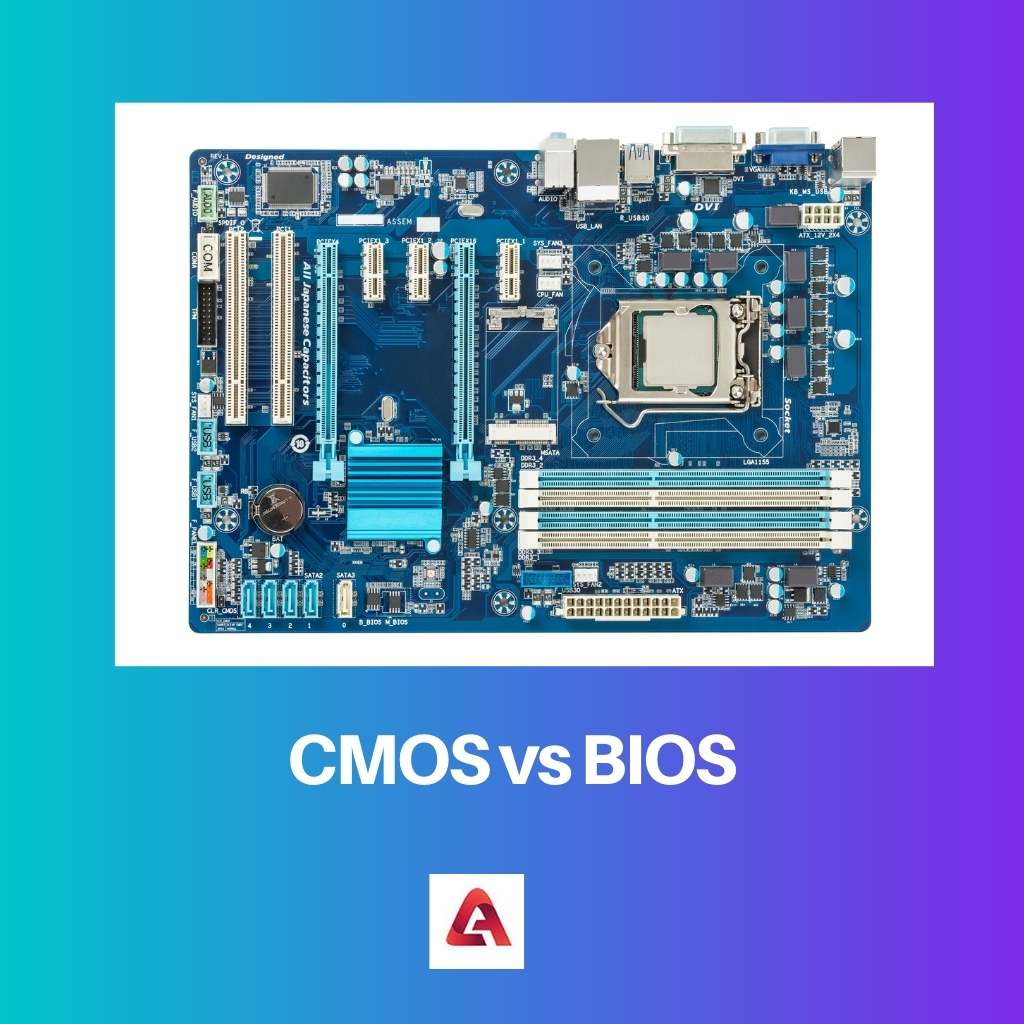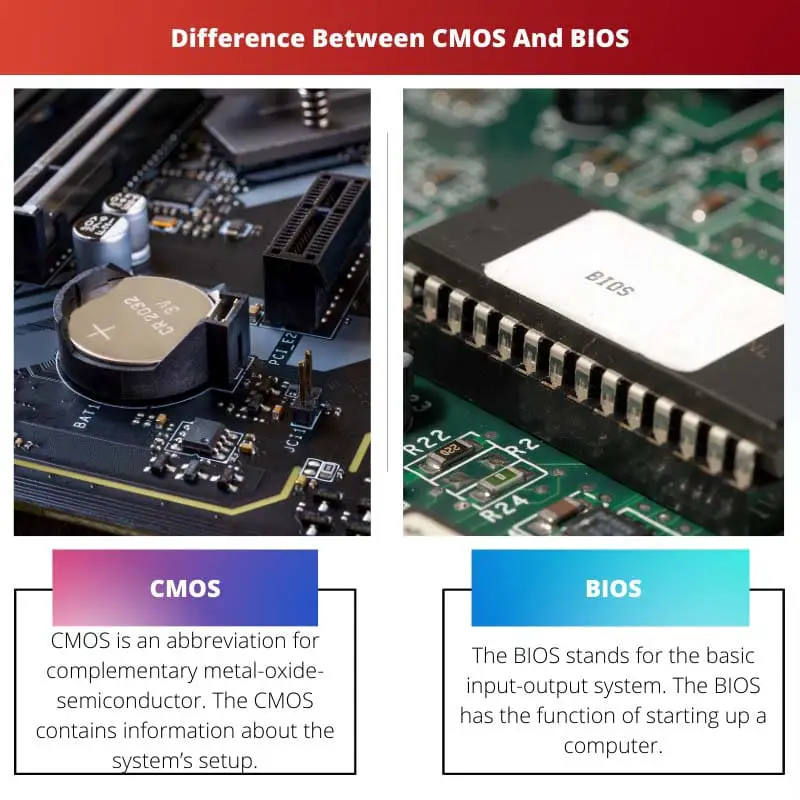A motherboard is an essential piece of hardware in a computer. It enables multiple computer components to interact with one another. CMOS and BIOS are two components on the motherboard.
Several people mistakenly believe that the CMOS and BIOS are the same things, although they are not. Both are distinct computer elements, yet they work in conjunction to ensure the computer’s correct operation.
Key Takeaways
- CMOS is a type of memory that stores hardware settings for a computer, while BIOS is firmware responsible for booting the system and managing hardware communication.
- BIOS is stored on a non-volatile memory chip, while CMOS stores data in volatile memory, requiring a battery to maintain its data when the computer is off.
- BIOS initializes and tests hardware components during startup, whereas CMOS stores user-configurable settings like date, time, and boot sequence.
CMOS vs BIOS
CMOS (Complementary Metal-Oxide-Semiconductor) is a type of semiconductor technology used in the creation of integrated circuits. BIOS (Basic Input/Output System) is a firmware program embedded in a computer’s motherboard and controls the computer’s startup process.

CMOS is an abbreviation for complementary metal-oxide-semiconductor. The CMOS contains information about the system’s setup. It is a memory device with volatile storage.
The BIOS configuration is stored and maintained in CMOS memory, a unique storage sort. The CMOS microchip is found in a computer program’s Southbridge.
The BIOS stands for the basic input-output system. The BIOS has the function of starting up a computer.
It completes device initializing when the computer boots up and provides operations for the operating system. The BIOS is a software type called firmware. It has a non-volatile memory. The BIOS is in the motherboard.
Comparison Table
| Parameters of Comparison | CMOS | BIOS |
|---|---|---|
| Full-Form | Complementary metal-oxide-semiconductor | Basic input/output system |
| Function | Stores system configuration | Starts up a computer |
| Type of software | Memory technology | Type of firmware |
| Type of Memory | Volatile memory | Non- volatile memory |
| Location of Placement | Located in Southbridge | Located in Motherboard |
What is CMOS?
CMOS is an acronym for Complementary Metal-Oxide Semiconductor. It is a component of the motherboard. It is a type of memory chip that maintains configuration settings and is powered by an integrated battery known as a CMOS battery.
A CMOS battery is a product that offers power to the Real-Time Clock whether the computer is turned on or off. When changes are implemented to the BIOS settings, the alterations are saved to the CMOS chip.
Two kinds of transistors are used in tandem to generate a present gate in CMOS technology, and it serves as an efficient method of electrical control. When not being used, CMOS transistors require almost little power.
However, when the current trajectory changes faster, the transistors get hotter. This property limits the speed at which microprocessors may work.
The CMOS is powered by a coin-sized CR2032 cell battery known as the CMOS battery.
Most CMOS batteries will survive the life of a motherboard, up to ten years in most situations, but may need to be changed depending on how the device is utilized.
A dead or failing CMOS battery is characterized by incorrect or sluggish system date and time and the loss of BIOS settings. It is as simple as changing out the dead one with a fresh one to replace them.

What is BIOS?
The BIOS, or Basic Input Output System, is a relatively small piece of code stored on a chip on your computer motherboard. When you turn on your computer, the first software that launches is BIOS.
It recognizes the hardware on your computer, configures it, tests it, and connects it to the software for further instruction. This is known as the boot procedure.
When you enter the BIOS setup application, you may adjust the boot process sequence as well as a range of hardware parameters. It is not suggested for an unpracticed consumer to alter BIOS settings unless advised to by a reliable source.
BIOS constraints eventually led to the development of a new firmware interface known as Unified Extensible Firmware Interface, or UEFI. UEFI is comparable to BIOS.
The BIOS firmware is pre-installed on the system board of a personal computer and is the first program to start when the machine is switched on.
Most BIOS implementations are tailored to function with a given computer or motherboard type by connecting with several components, most notably the system chipset.
Originally, BIOS firmware was stored on the PC motherboard on a ROM chip. Later computer systems contain the BIOS contents on flash memory, allowing it to be overwritten without removing the chip from the motherboard.

Main Differences Between CMOS And BIOS
1. The CMOS stands for complementary metal-oxide-semiconductor, and the BIOS stands for the basic input-output system.
2. The CMOS stores system configuration information. Meanwhile, the BIOS starts up a computer.
3. The CMOS is a memory technology, whereas the BIOS is a software type called firmware.
4. The CMOS has volatile memory, but the BIOS has a non-volatile memory.
5. The CMOS chip is located in the southbridge of a computer system, and the BIOS is located in the motherboard.

- https://ieeexplore.ieee.org/abstract/document/6161909/
- https://search.proquest.com/openview/a8d9276f5ca77b4dadcfea991a9816d4/1.pdf?pq-origsite=gscholar&cbl=2035011

Excellent overview. An informed understanding of computer hardware is always helpful, even if some may not find it entirely relevant.
Not sure why anyone needs to know about this outdated technology. Most users will never interact with CMOS or BIOS ever in their life.
This feels like a college lecture. Such a wealth of information in this article.
This is really informative. I’ve known about these things for years, but I wouldn’t have been able to explain it nearly as well. Kudos!
Very useful information, I have always wondered about the differences between CMOS and BIOS. Thank you!
This goes beyond a basic explanation and delves deep into the subject. Great article.